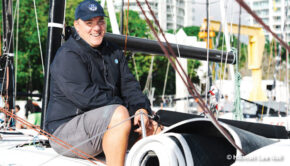Implementing your winning strategy
Published on February 13th, 2022
For Sailing World, pro sailor Steve Hunt shares his observations that the bigger the fleet, the harder it can be to score consistent top finishes, but a couple of young 420 aces show how it can be done.
For a couple of years, I’d been watching the results for Club 420 racing, and two names always kept appearing at the top: Cordelia Burn and crew Sarah Moeder, from Bay Head YC in New Jersey. I really wanted to know how they managed to win almost every Club 420 event they entered, some by wide margins. Since they were an East Coast team and I coach on the West Coast, I’d never seen them race. But this past July, at the 2021 Club 420 Nationals in New Jersey, I got my chance.
There, I observed and got a few great videos of Burn and Moeder implementing their winning strategy, and as luck would have it, I got to coach our group of West Coast sailors along with coach Sarah Burn, Cordelia’s older sister, who also dominated the C420 class until she moved on to college. Sarah told me her younger sister was pretty conservative on the starting line, seldom started at an end, avoided major errors and was very fast. In watching them, that’s exactly what I saw.
We were coaching a big group of mostly West Coast sailors, which included the eventual winners of the event, Piper Holthus and Sophia Pearce, both on a team I started coaching during the pandemic called NB4T, or Newport Beach 420 Team, based out of Bahia Corinthian YC. Holthus and Pearce followed a similar starting strategy to Burn and Moeder: They were also really quick around the track and sailed super-smart upwind legs.
After the first day, they were in the top of the fleet. In our evening debrief, Holthus, the skipper, provided a succinct explanation of their upwind sailing strategy that was nothing short of brilliant in its simplicity. Their decision-making mostly involved the compass headings and the crew calling percentages to layline.
The Start
For this event, the 132-boat fleet was split into two groups, which meant there were 65 boats on the line. It was a big line, and before the start, Burn and Moeder hung out above the center of the starting line, near the gate area, about five boatlengths to windward. In that time, they looked upwind for pressure and did a few head-to-winds to keep track of the shifts.
They’d already figured out the bearing of the starting line, and their wind checks were to figure out the favored end of the starting line and recognize which phase the wind was in. That helped them make a game plan for where they wanted to start and where they wanted to go on the first beat. – Full Story









 We’ll keep your information safe.
We’ll keep your information safe.